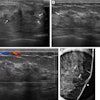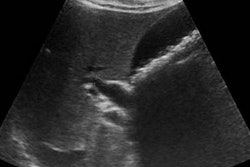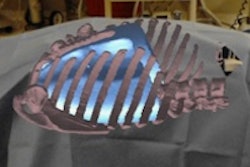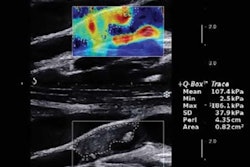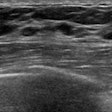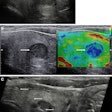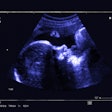
Is the off-label use of ultrasound-guided injection of recombinant thrombin for treating extremity pseudoaneurysms safe and effective? Yes, according to a 10-year retrospective analysis published in the August issue of the Journal of Ultrasound in Medicine.
In a study of more than 250 patients, researchers from Hofstra Northwell School of Medicine in Manhasset, NY, found that the procedure was effective in more than 85% of cases, with a recurrence rate of approximately 11%. Only 3% of procedures had a complication.
"Thrombin injection of pseudoaneurysms is an off-label procedure with few complications and a high success rate," wrote study authors Dr. Yonah Esterson and Dr. John Pellerito.
Pseudoaneurysms
A pseudoaneurysm -- an extravascular collection of blood that forms from a defect in the arterial wall -- occurs after focal damage to the vessel wall. While this damage can occur after trauma, it most commonly develops after an interventional procedure in which adequate hemostasis was not achieved, according to the researchers. Blood may flow out of the vessel at the puncture site and into the surrounding soft tissues, forming a pseudoaneurysm.
These pseudoaneurysms are at risk for acute rupture and are associated with hemodynamic compromise. They can also cause pain, swelling, overlying skin ischemia, and compression of nearby structures, according to the researchers.
"Therefore, pseudoaneurysms require close follow-up to ensure thrombosis and avoid complications," they wrote.
Treatment options include surgical closure of the vascular defect after evacuating the blood-filled pseudoaneurysm sac, as well as ultrasound-guided compression of the pseudoaneurysm neck to obliterate blood flow into the pseudoaneurysm. Ultrasound-guided compression is a time-consuming and painful procedure, however, and reported success rates range from 63% to 88%, according to the researchers.
A third option -- ultrasound-guided injection of recombinant thrombin into the pseudoaneurysm sac to achieve thrombosis -- has become standard treatment for extremity pseudoaneurysms, despite being an off-label procedure. A 2016 review and meta-analysis concluded that ultrasound-guided thrombin injection was significantly more efficacious than ultrasound-guided compression, and just as safe.
Other studies have also found the procedure to be safe and effective, but most have had small sample sizes and few have focused on the need for follow-up imaging or described the factors associated with pseudoaneurysm recurrence, according to the researchers.
A 10-year review
Esterson and Pellerito set out to retrospectively review cases of ultrasound-guided thrombin injection of pseudoaneurysms performed over a 10-year period to assess the procedure's success and complication rates, as well the rate of pseudoaneurysm recurrence. They also wanted to determine the factors associated with failure of complete and sustained pseudoaneurysm thrombosis in order to recommend appropriate follow-up imaging (J Ultrasound Med, August 2017, Vol. 36:8, pp. 1617-1624).
The researchers identified all cases of ultrasound-guided repair for pseudoaneurysm at their institution between January 1, 2006, and March 20, 2016. Patients were included in the study only if they also received a follow-up ultrasound exam -- performed at a median of one day after the procedure -- to confirm persistent thrombosis or to identify pseudoaneurysm recurrence. Over the 10-year period, 262 ultrasound-guided thrombin injections were performed on 261 iatrogenic pseudoaneurysms and one traumatic pseudoaneurysm. However, 32 patients were lost to follow-up and excluded from the analysis.
All ultrasound-guided injections were given as the standard of care and were performed by a radiologist or a vascular surgeon with image guidance provided by the radiology department. The practitioner had discretion as to the rate of thrombin injection. The researchers considered procedural success to be a complete thrombosis at the time of injection and on a follow-up examination, while procedural failure was defined as an incomplete thrombosis at the time of injection or the presence of flow within the pseudoaneurysm sac on the follow-up ultrasound study.
Of the 230 cases, 197 (85.7%) achieved procedural success. The procedural failures included 25 (10.9%) postprocedural recurrent pseudoaneurysms and eight (3.5%) incompletely thrombosed pseudoaneurysms.
"It is noteworthy that repeated ultrasound-guided thrombin injection was attempted in 12 recurrent pseudoaneurysms and in two incompletely thrombosed pseudoaneurysms, and reinjection was successful in all 14 cases," the authors wrote.
Complications occurred in seven (3%) of the cases: Three were in successful procedures and four were in recurrent cases. The complications included five cases of intravascular thrombus formation and two infections.
Predictors of recurrence
The researchers did not find any significant association between pseudoaneurysm recurrence and variables such as patient age, sex, amount of thrombin injected, atypical pseudoaneurysm location, pseudoaneurysm complexity/number of pseudoaneurysm locules, leukocytosis, anemia, coagulopathy, renal failure, hyperglycemia, or hypoalbuminemia.
However, both a large pseudoaneurysm size and the presence of thrombocytopenia were significant independent predictors of pseudoaneurysm recurrence after ultrasound-guided thrombin injection.
A pseudoaneurysm size of at least 2 cm increased the odds of recurrence by 229% (p = 0.03), compared with size smaller than 2 cm. In addition, thrombocytopenia increased the odds of recurrence by 4%, compared with patients who had normal platelet levels (p = 0.04), according to the researchers.
"Based on these findings, short-interval follow-up imaging is recommended in all pseudoaneurysms that are 2 cm or larger in the greatest dimension and in patients with thrombocytopenia," they wrote.


